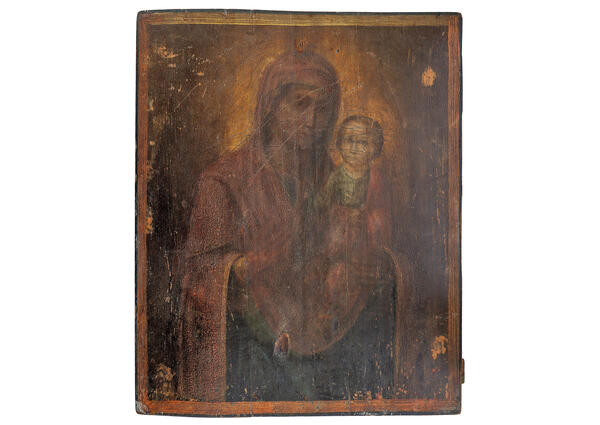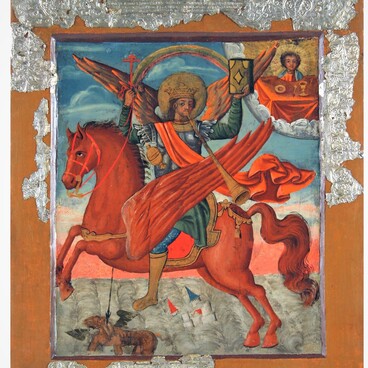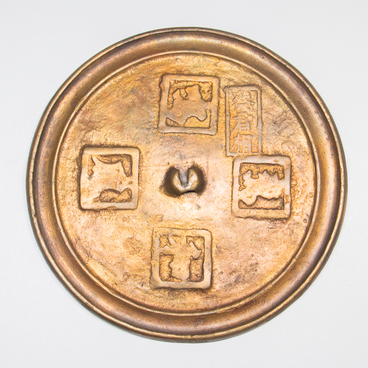Theotokos of Tikhvin displayed in the museum was painted in the second half of the 19th century. The base consists of three panels joined with two carved strips. These are the small wooden planks that were cut into the base backside or nailed to it.
The icon depicts the Virgin Mary with Jesus. They wear red flowing clothes. A golden glow surrounds their heads. At the bottom of the icon, one can see the remains of paraffin wax from candles.
This icon was kept in the village of Itkulovka, Muromtsevsky District, Omsk region. In the 1930-s, the church was destroyed, and the resident Aleksandra Grigoryeva saved the icon. She kept it in her house for some time, and in 2001, she gave the ancient relic to the Omsk State Museum of History and Regional Studies.
There are scratches and other damage on the icon. Researchers suppose that they appeared there in the first decades of Soviet rule. In 1918, the Communist party announced the need to promote ‘withering away of religious prejudices.’ In particular, it published a Decree on Separation of Church from State and School from Church. It abolished the functions of the Orthodox Church as a state institution patronized by the government.
Strict anti-religious measures were taken in the new revolutionary Russia. They included seizure and nationalization of church property, destruction of temples, and the churches' transfer to civic organizations. The People’s Commissariat of Justice issued two resolutions: about the organizational opening of the relics dated August 14, 1919, and about the nationwide liquidation of relics dated August 25, 1920.
The government actively engaged in anti-religious propaganda. For example, the publishing house “Bezbozhnik” (“The Godless”) was created which printed and distributed anticlerical literature. In 1925, on the basis of the Society of Friends of the eponymous newspaper, a mass social organization “The League of Militant Atheists” was founded. It existed until 1947. At the head of the society was a revolutionary Yemelyan Yaroslavsky (Gubelman).
The icon depicts the Virgin Mary with Jesus. They wear red flowing clothes. A golden glow surrounds their heads. At the bottom of the icon, one can see the remains of paraffin wax from candles.
This icon was kept in the village of Itkulovka, Muromtsevsky District, Omsk region. In the 1930-s, the church was destroyed, and the resident Aleksandra Grigoryeva saved the icon. She kept it in her house for some time, and in 2001, she gave the ancient relic to the Omsk State Museum of History and Regional Studies.
There are scratches and other damage on the icon. Researchers suppose that they appeared there in the first decades of Soviet rule. In 1918, the Communist party announced the need to promote ‘withering away of religious prejudices.’ In particular, it published a Decree on Separation of Church from State and School from Church. It abolished the functions of the Orthodox Church as a state institution patronized by the government.
Strict anti-religious measures were taken in the new revolutionary Russia. They included seizure and nationalization of church property, destruction of temples, and the churches' transfer to civic organizations. The People’s Commissariat of Justice issued two resolutions: about the organizational opening of the relics dated August 14, 1919, and about the nationwide liquidation of relics dated August 25, 1920.
The government actively engaged in anti-religious propaganda. For example, the publishing house “Bezbozhnik” (“The Godless”) was created which printed and distributed anticlerical literature. In 1925, on the basis of the Society of Friends of the eponymous newspaper, a mass social organization “The League of Militant Atheists” was founded. It existed until 1947. At the head of the society was a revolutionary Yemelyan Yaroslavsky (Gubelman).



